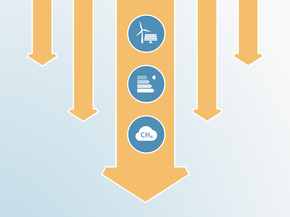Pledges And Targets
Summary table

Paris Agreement targets
Chile’s NDC
Chile’s NDC includes two emissions mitigation targets for 2030:
- Unconditional: 30% reduction of GHG emissions-intensity of GDP compared to 2007 by 2030 (Government of Chile, 2015). With an average annual projected GDP growth of 3% over the period 2017 to 2030 (Ministerio de Energía, 2017b), we estimate this option results in emissions levels of 131 MtCO2e by 2030 (152% above 1990 and 44% above 2010 GHG emissions levels excluding LULUCF).
- Conditional on international financial contributions in the form of grants: 35–45% reduction of GHG emissions-intensity of GDP compared to 2007 by 2030 (Government of Chile, 2015). We estimate this option results in emissions levels of 103–122 MtCO2e by 2030 (98–135% above 1990 and 12–33% above 2010 GHG emissions levels excluding LULUCF).
Both of the GHG emissions intensity targets do not include emissions or removals from the forestry sector. In its 2015 NDC, Chile proposes separate targets to address only this sector: a) sustainable management and recovery of 100,000 hectares of forest by 2030 with estimated emissions reductions of 0.6 MtCO2e per year from 2030 and b) commitment to afforest 100,000 hectares, with mostly native species, that are estimated to capture between 0.9–1.2 MtCO2e per year from 2030 (Government of Chile, 2015). These targets are conditional on the approval of updates to the Native Forest Law and a new Forest Promotion Law, neither of which were in place as of May 2019.
Chile’s proposed updated NDC (2019)
Chile’s NDC update proposal was released for public consultation in October 2019 (Ministerio del Medio Ambiente de Chile, 2019). It includes two emissions mitigation targets for 2030:
- Unconditional:
- An economy-wide target excl. emissions or removals from the Land Use, Land Use Change and Forestry (LULUCF) sector of 97 MtCO2e in 2030.
- This target includes three components:
- GHG emissions budget of between 1110 and 1175 MtCO2e between 2020 and 2030
- A peak year for GHG emissions: 2027
- Three targets for the LULUCF sector:
- Sustainable management and recovery of 200 000 hectares of native forest, equivalent to a GHG emissions capture between 0.9 and 1.2 MtCO2e/yr by 2030
- Reforestation of 200 000 hectares of forest, from which at least half correspond to permanent forest coverage, from which at least 70 000 hectares should be native species. This is equivalent to a GHG emissions capture between 3 and 3.4 MtCO2e/yr by 2030
- Reduce emissions from deforestation and land degradation of native forest by 25% by 2030, taking average emissions between 2001-2013
- Conditional on international finance:
- Reduction of up to 45% net GHG emissions from 2016 levels, by 2030. The sectoral coverage of this target has not been specified in the draft NDC update proposal.
This proposal specifies linking its 2030 target to its long-term goal for carbon-neutrality in 2050 as well as linking the NDC targets to planning processes involving governance, existing and future strategies including the “Long-term Climate Strategy 2050.”
It also includes a target to reduce black carbon emissions by 10% - 25% below 2016 emission levels, by 2030. It also has two adaptation targets: one including administrative measures on the sectoral adaptation plans, and a second including the sectoral adaptation targets.
Black Carbon and Chile’s NDC
Chile’s proposed NDC update includes a target to reduce black carbon emissions, which has substantial co-benefits for human health. However, reductions in black carbon are generally not additional to reductions in CO2 emissions, because large fractions of black carbon emissions stem from the same emission sources as CO2. Emission reduction policies therefore often reduce CO2 and black carbon simultaneously, and this is already included in calculations of the emissions reductions required to hold warming well below 2°C globally, like the “emissions gap” and “fair share” reductions (see next section on Fair Share).
In its most recent Fifth Assessment Report (AR5), the IPCC did not provide calculations of Global Warming Potential for black carbon comparable to those provided for greenhouse gases, merely noting the inherent difficulties in doing so and limiting itself to displaying estimates from the pre-AR5 literature.
The CAT’s evaluation indicates that:
The proposed unconditional NDC provides improvements in transparency, ambition and governance. If Chile were to officially adopt this plan, we would rate it “Insufficient.”
The “Insufficient” rating indicates that Chile’s proposed updated unconditional climate commitment in 2030 is not consistent with holding warming to below 2°C, let alone limiting it to 1.5°C as required under the Paris Agreement, and is instead consistent with warming between 2°C and 3°C. If all countries were to follow Chile’s approach, warming would reach over 2°C and up to 3°C. This means Chile’s climate commitment is at the least stringent end of what would be a fair share of global effort, and is not consistent with the Paris Agreement’s 1.5°C limit, unless other countries make much deeper reductions and comparably greater effort.
The proposed new conditional target - subject to climate finance - is close to or compatible with Chile’s fair share Paris Agreement’s 1.5°C range. However, in contrast to the unconditional NDC proposal, this target provides no clarity on sectoral coverage, rendering it difficult to evaluate. For our analysis we have assumed that reductions from “net emissions in 2016” refers to economy-wide emissions incl. LULUCF in 2016, and thus estimated a range of total emissions excl. LULUCF in 2030 based on the following assumptions:
- For the upper end of the range we have estimated total emissions excl. LULUCF as the difference between total emissions incl. LULUCF and LULUCF emissions in 2030 if the first are a 45% reduction from those in 2016 and LULUCF emissions are the same as in 2016.
- For the lower end of the range we have total emissions excl. LULUCF in 2030 as a 45% reduction of total emissions excl. LULUCF level in 2016. The LULUCF level then is estimated as the difference between total GHG emissions incl. LULUCF and total GHG emissions excl. LULUCF.
Depending on the assumptions made, this target could be rated either “2°C compatible” or “1.5°C Paris Agreement compatible”, but only if it were unconditional. If this conditional target were to refer to a 45% GHG emission reductions from 2016 economy-wide emissions excl. LULUCF, the CAT would rate it “1.5°C Paris Agreement compatible,” indicating efforts in the most stringent part of Chile’s fair share range.
The CAT estimates that by implementing all of its planned policies, Chile could peak its emissions in 2023, which would be earlier than the proposed peak in 2027, this would be a remarkable achievement and set the country up as a front-runner on climate action. Under this scenario the carbon budget between 2020 and 2030 would be 5-9% lower than the carbon budget presented in the draft NDC update document.
2020 pledge
Chile has proposed to undertake NAMAs to reach an emissions reduction of 20% below BAU including LULUCF in 2020 (as projected from 2007). We estimate this is an absolute pledged emissions level of 122 MtCO2e in 2020 excluding emissions and sinks from LULUCF. This is equivalent to an increase of 135% from 1990 GHG emissions levels, excluding LULUCF. According to our current policy projections, Chile is well on track to overachieve its 2020 pledge.
Long-term goal
In June 2019, Chile announced its aim to achieve carbon neutrality by 2050 (Gobierno de Chile, 2019b). While this is highly dependent on the size of the forestry sinks, we estimate the lower end of the range would be consistent with the CAT rating category of 1.5°C Paris Agreement compatible.
Further analysis
Latest publications
Stay informed
Subscribe to our newsletter




